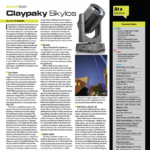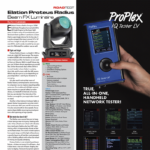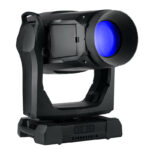Newer-generation touchscreen devices have always held the promise of new and exciting ways for us as lighting designers and programmers to interact with our rigs. Carrying around a small tablet at a show beats standing behind a console in many situations — walk onto the stage and focus your movers on a particular spot instead of squinting from FOH, or explore during a show to get a different perspective. Previous control solutions were mostly console software shoehorned into the device’s OS, which was hardly ideal. Enter Vibrio from Toast Mobile, an application built from the ground up to control small to midsize rigs on Apple’s iPad family of devices.
Vibrio works by connecting to a wireless network and talking to a DMX adapter, such as the Enttec ODE or DMXKing eDMX1. Once the network is configured, you need only a router and DMX adapter to start controlling your lights with Vibrio.
Getting Started
One of the first things you notice when you start the program is how intuitively the program is laid out. Main functions are listed as icons on the left-hand side of the screen — scenes, effects, garand master, etc. — and touching these brings up that page. The program works with two different playback paradigms, Scenes and Sequences. A scene records attributes for playback, and sequences work as a series of scenes, which have editable fade and hold times. You can also stop the default “looping” playback of sequences and step through the sequence, as on other consoles. Patching is simple and intuitive; you simply find the lights you want in the built-in library, select the number of fixtures, and the application patches them for you sequentially. The built-in library isn’t large at this time, but there’s a function to create your own custom fixture personalities if you’re truly in a pinch and need a personality file. Vibrio says they’re always working on adding more fixtures to the library.
Groups, Scenes and Sequences
The program automatically creates groups of like fixtures for you, and the user has the option of including those fixtures in a scene or not. As you’d expect with any other console, groups not referenced in a scene do not affect those lights when they’re running in other scenes. This allows you to layer scenes of separate groups of fixtures without the parameters conflicting. To edit a scene, you simply tap on its tile and select edit. Once on the editing screen, you can set colors with a color picker for color mixing fixtures, and pan and tilt information on an X-Y coordinate system. The rest of the attributes for each fixture are at the bottom of this page, and can be included in the scene or not — again, for overlaying with other scenes, which should be extremely useful for running on the fly when you don’t want attributes to get overridden. You can also add effects from this screen, and there’s a very usable library of built-in effects that can be accessed.
Effects
Users can also build their own effects within the program, though you’re currently limited to movement, color, and dimmer effects. Users can set the order that the effect is applied across fixtures, the fade type (snap or fade) and the distribution across fixtures. Currently, only RGB attributes are supported for color effects, but the company is working on adding in support for CMY, as well as effects on other attributes, such as iris or frost. There’s also an easily-accessible tap tempo for syncing your effects to the music quickly. The program also includes a real-time graph of output, which they call a visualizer, though it does not display graphical representations of a stage or lights. Instead, parameters are shown on a graph-like screen showing real time parameters as bars corresponding to the DMX levels of whatever attribute it’s displaying. Ensuring your show data stays safe is also critical, and Vibrio has backup and export functions to ensure continuity of data and for sending shows to other devices.
At a Glance
Functional, Not Flashy
Vibrio is a new DMX lighting control software for the iPad. It connects to the lights wirelessly using an Ethernet-to-DMX converter and the Art-Net protocol. It works as an easy and seamless control solution, and the layout is easy to use and fast — this program doesn’t try to wow you with special effects, it displays the relevant information to the operator for fast and efficient programming and show management.
Vibrio iPad App
PROS: Good program to run a few fixtures on or control dimmers. Easy to figure out.
CONS: None
Specs
- Version: 1.1.0
- Size: 15.6 MB
- Language: English
- Seller: Tobey Osborne/Toast Mobile
- Compatibility: Requires iOS 8.0 or later. Compatible with iPad.
- MSRP: You can download the app and get 16 free DMX channels. One can purchase an additional 256 DMX channels for $39.99 or 512 channels for $79.99
More Info: www.plsn.me/VibrioApp



